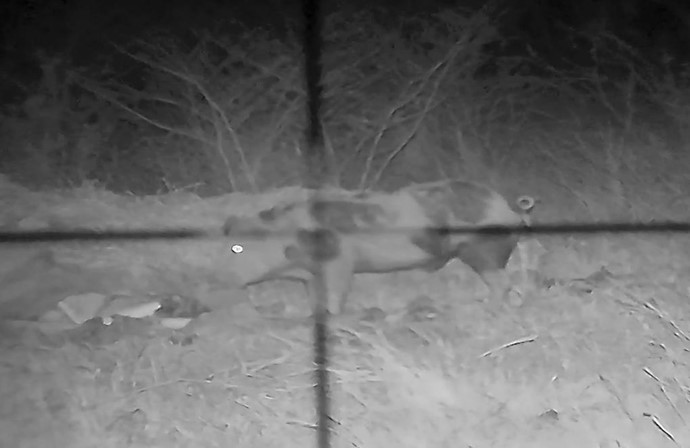Members will note my preference for hard cast HP .30-30 bullets for killing pigs, based on long experience and not paying much attention to the alternative.
There is another school of thought that prefers soft bullets with or without a small hollow to initiate expansion. Proponents claim that soft bullets expand without breaking up, whilst hard bullets are said to shatter. The hollow noses of the hard bullets certainly break up, doing a lot of damage in the process, but I have found no evidence of “shattering” beyond the noses.
The process of expansion with hard HP rifle bullets is that the nose breaks apart and creates its own cone of destruction, while the base continues to penetrate, being ground down and shortened as it passes through the pig. The nose shattering is not instant, evidenced by exit wounds on rib shot sows of upwards of 3/8” diameter.
My ideal bullet for pigs, cast or otherwise, will give sufficient penetration on a large boar to pass through one shoulder and at least into the second, while at the same time making lethal lateral damage on a smaller pig shot through the ribs. This level of penetration incidentally is enough for shooting “doubles” on smaller pigs.
At the hard alloy end of the spectrum, I use a .30-30 bullet weighing 176 gns with gas check and lube, alloy about 11% non-lead, mv 2200 fps, and hollow of 10 gns (5.5% of original bullet weight). Five shot groups average about 2.5 minutes at 100 meters. For comparison, linotype bullets (16% non-lead) from this mould weigh 164.5 gns. These bullets are #U321297HP, sized down from .322” to 312”.
The higher velocity is critical to getting the required performance from the hard hollow points, and it is about making the bullet break, not just putting more smack on the hog.
The hollow for this bullet, as per Lyman is .113” at the nose, .080” at the base, and .500” deep. Total bullet length is 1.025”.
Having defined what works with hard alloy, I remain interested in what can be achieved with soft bullets, and have been investigating. An alloy of 3.5% non-lead (wheelweights & solder) from the same mould produces a bullet of 192 gns with gas check and lube. With LVR powder I get 2100 fps with one grain less powder than used for the hard HPs, allowing for the heavier bullet. A single test group went 2.5 minutes.
Testing so far indicates excessive penetration and insufficient lateral destruction with the soft solid bullets. Some hollow is required to initiate expansion, but how much? I have the Forster hollow pointing tool with 1/8” drill, used on loaded cartridges.
Drilling to remove 4 gns (2%) of bullet weight makes a hollow a little over 1/8” deep. A boar shot quartering front on shoulder to flank with one of these went straight down. A second mature boar shot through both shoulders and spine also went straight down (first image) but had to be finished. More to the point, the bullets on both boars went right through, which is still more penetration than I want.
Edit: I should stress also that too much hollow for the alloy or alloy too soft for the hollow will result in lack of penetration and thus wounding. Therefore we are looking for the right combination of hollow and alloy.
Images are in each case the last frame of the video before the white flash. They are included to indicate actual point of aim.

Next step was drilling to remove 6 gns (3/16").
The first pig shot was a young boar walking across my front at about 75 meters. Intention was to hit the shoulder. He dropped to the shot, but a short while later got up and ran off. A second shot with a hard HP was required. Circumstances prevented me determining shot placement and penetration, but I was unimpressed by his getting up again.
A second young boar was shot (next image). Bullet went in through the shoulder and out through the ribs. The pig vanished into the night before the smoke had cleared, but turned up in the morning 45 meters away. With the regular hard HP bullets I might have expected a knockdown.
.jpg?width=690&upscale=false)
The next kill was an immature boar shot in the shoulder (image below). He ran 34 meters.
.jpg?width=690&upscale=false)
The 1/8” drilled hollow may not be strictly comparable with the narrower deeper Lyman hollow. The wider hollow and softer metal may result in finer shrapnel, which I would expect to be less damaging to the pig. If I were to continue this investigation I would prefer to be using the 1/16” hollow. For the same weight removal, depth of 1/16” hollow would be 4X the depth of 1/8” hollow.
The other hypothesis is that the soft bullet “mushrooms” and holds together better. This might be the case with larger calibres and lower velocities, but I wonder about it happening at 2200 fps in a .30-30. Does the “mushroom” actually persist, or does the hollow portion come apart as for the hard bullets, leaving the rest of the bullet to be ground down by its passage through the pig? And what is left at the finish? With none of the test bullets recovered I am none the wiser. And does it matter anyway, or is it just more satisfying for the shooter to recover a mushroom than a slug?
The softer .30-30 bullets can certainly be made more effective by hollow pointing, but so far I remain unconvinced that they are as good on pigs as the hard hollow point bullets shot at full velocity. Other rules will apply to larger calibers at lower velocity, and to quarry other than pigs.













